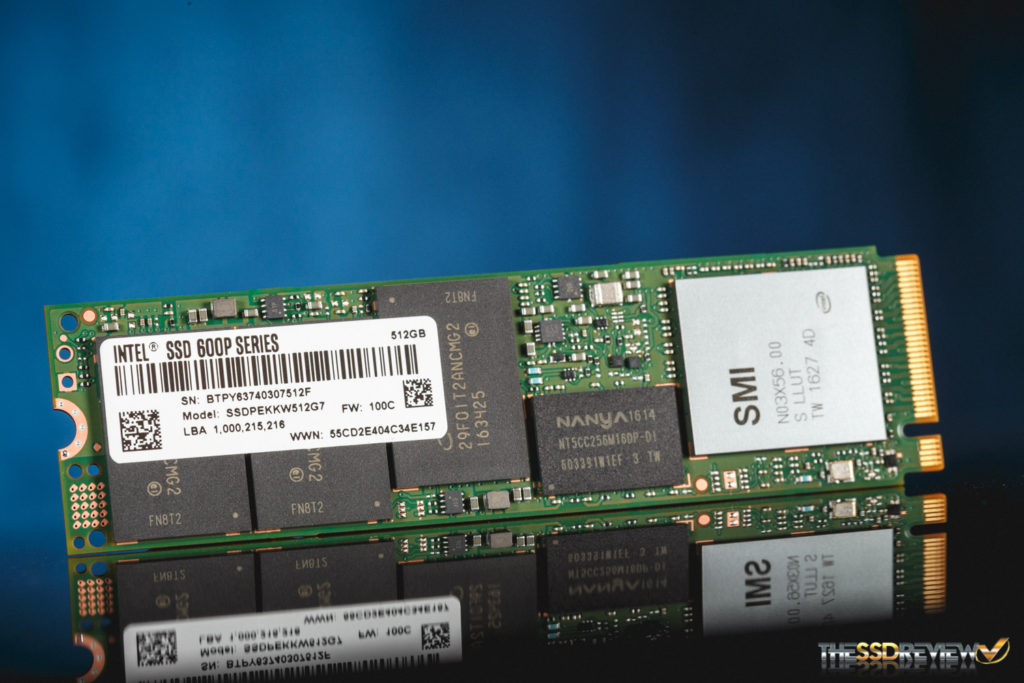Back in April of 2015 Intel was the first company to release an NVMe SSD into the consumer marketplace. The Intel 750 was the new standard in PCIe performance storage. Now, with the greater support for M.2 devices, however, Intel decided it was time to release a new NVMe product, one that is much more compact and a much more economical choice from a price perspective. The SSD we are talking about today is the Intel 600P. It is designed to close the gap between PCIe and SATA SSDs. For just a few dollars more than a SATA SSD, you can grab one of these and have reads that are up to three times faster than any SATA SSD can deliver. Paired with SMI’s SM2260 controller with their homebrewed firmware and IMFT’s 1st generation 3D TLC NAND, the relatively low-cost 600P can achieve some pretty fast speeds of up to 1.8GB/s for read, but when it comes to writes, there is a catch. Read on to learn what it is and more as we poke, prod, and dissect the 512GB Intel 600P in today’s review!
SPECIFICATIONS, PRICING, AND AVAILABILITY
The Intel 600P is a PCIe 3.0 x4 NVMe that comes in an M.2 2280 form factor. It is available in capacities of 128GB ($51), 256GB ($87), 512GB ($156), and 1TB ($365). Looking at the performance figures, we have to admit, for an M.2 SSD, they aren’t that great, but at these prices compared to SATA options, they are very alluring. The 128GB model is rated for 770MB/s read and 450MB/s write. The 256GB model is rated for 1,570MB/s read and 540MB/s write. The 512GB model we are testing today is rated for 1up to 1775MB/s read and 560MB/s write. Finally, the 1TB model is rated for up to 1.8GB/s read and 560MB/s write. Write performance is similar to that of SATA, but to top that off, there is also an SLC cache that ranges from 3GB, 6GB, 16GB, to 32GB depending on the capacity. So, the lower capacity models will slow down during sequential writes much faster than the higher capacities…and that is the catch we spoke about earlier. We will test the base write performance later in testing to show you just how slow it can get.
In terms of IOPs, the 128GB doesn’t deliver the best performance, but is rated for up to 35K/91K read/write. The 256GB model is at 71K/112K, the 512GB model is at 128.5K/128K, and the 1TB model is rated for up to 155K/128K read/write. The endurance of the 600P is 72TB, 144TB, 288TB, and 576TB respective to each capacity from 128GB through to the 1TB model and it is covered by a 5-year warranty.
The features and accessories list is quite small for the Intel 600P. It doesn’t have hardware encryption support, but it does support TRIM, SMART, and is RoHS compliant. You can also head over to Intel’s website and download their SSD toolbox for this SSD. With it you can diagnose the drive, update the firmware, secure erase it, manually trigger TRIM, and even tune your system.
PACKAGING AND COMPONENTS
Intel’s packaging has a blue and green warp speed design that reiterates this PCIe drive’s speed potential. SSD6 are in big, bold letters on the front, designating this as a 6 series SSD. On the backside are all the drive’s specifics such as form factor, warranty, and capacity.
The SSD itself is encased in a clamshell that is in a cardboard sleeve, similar to how Intel packages their CPUs. Included with the SSD is simply a warranty and installation pamphlet.
The 512GB model we are testing today has a single-sided PCB that is just 1.5mm thin, which is great for the newest thin profile laptops that accept these drives. There are three Intel 384Gb (48GB per die) 32-layer 3D TLC NAND packages, a single NANYA DRAM package, and a single SMI2260 controller.
In total, the usable capacity for the end user is 476GB, the excess NAND is utilized for garbage collection, wear leveling, and the SLC cache buffer. The controller is large compared to many other M.2 controllers and is capped with a metal heat spreader that should aid with heat dissipation.
 The SSD Review The Worlds Dedicated SSD Education and Review Resource |
The SSD Review The Worlds Dedicated SSD Education and Review Resource | 


Passed my first test-At least 8K-IOPS-QD1.
Failed my second-Must write 200+ after buffer
can’t have it bottleneck my spinning rust.
Write speed shocked me for a 500 size drive
those speeds you expect on a 120 size drive.
And why the SLC cache so small???????
The ATTO results make sense as the 600p doesn’t have a controller that supports direct to die algorithm to relieve the bottle neck that occurs once the SLC cache is full. That being said very few program reads, go above 128K in windows. So, everything past that is just large file transfer, and really inconsequential in day to day compute performance outside of OS install.